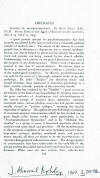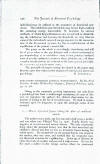STUDIES IN PSYCHOPATHOLOGY. By Boris Sidis, A.M., Ph.D. Boston Medical and Surgical Journal (in five numbers), March 14-April 11, 1907. A great general interest in psychotherapeutics has been recently manifested by the laity as well as by a constantly growing number of medical men. The extent of the interest is so widespread that it threatens to degenerate into a mental epidemic. In fact, one church helped by physicians has already taken up the work and patients are being treated by the church officials. Unfortunately, such activity on the part of physicians may retard the progress of psychotherapeutics. What is true of diseases in general is also true of mental diseases. We can not hope to develop a rational psychotherapeutics without a scientific study of the pathological conditions. An effective psychotherapeutics can only be the result of a thorough scientific study of psychopathology. Dr. Sidis' "Studies" are therefore timely and should stimulate those interested in abnormal psychology to a close, careful scientific analysis of the cases they handle. Dr. Sidis has rendered by his "Studies" a great service to all workers in the field of psychopathology by bringing unity into the great confusion of classifications and subclassifications of the various groups of insistent ideas, imperative concepts, emotional states, various phobias, motor tics and psychic attacks usually classed as "psychic epilepsy," meaning the psychic equivalent of epilepsy. He applies the psychobiological principle of recurrent moment consciousness which he has worked out at great length in his former works, more particularly, in his "Psychopathological Researches" and in his "Multiple Personality" to a group of cases of functional psychosis which he analyses with great detail and precision. All the manifestations of the symptom complexes of his cases including insistent ideas, imperative concepts, phobias, emotional states, and psychomotor, attacks, all these are shown to be the manifestations of recurrent disaggregated subconscious states. The disaggregation of consciousness may have taken place in the early life of the patient and the dissociated states thus formed may have remained dormant. When once set into activity these subconscious states recur either periodically or exist continuously in consciousness, to the agony and discomfiture of the patient. These recurrent states are characterized by their sudden onset, their violence and by their excessive amount of energy. Each attack is an exact reproduction of every other, both in its content of consciousness and in its psycho-motor reactions. The symptoms of which the patient complains appear to him meaningless and unintelligible, he can find no explanation for them. Nor is it always possible to find an explanation for these symptoms by the most careful scrutiny into the patient's life and his environment, inasmuch as the subconscious states producing the symptoms may have been disaggregated in early childhood and have completely lapsed from the patient's conscious memory. To effect a cure the disaggregated subconscious states must be synthetized with the rest of the patient's mental life. Such a synthesis re-establishes the associational relations and inhibits the activity of the states formerly dissociated. The synthesis is not that of the Breuer-Freud cathartic method, it is accomplished by various methods, all based on the principle of subconscious reserve energy. The method which Sidis has used so successfully in the number of cases he reports is what he terms the method of hypnoidization, a method not to be confused with Janet's or with Freud's methods. Briefly stared it consists in placing the patient in a quiet darkened room in an easy relaxed position and have him listen to a monotonous sound. The patient is then required to tell what passed through his mind when he listened to the sound. Fragments of long-forgotten experiences will flash through the patient's mind, and by piecing together these fragments a complete account can be obtained which will explain the otherwise unintelligible and whimsical symptoms. The state induced by this method Sidis designates as the "hypnoidal" state, a state which is between waking life on the one hand and hypnosis and sleep on the other. But what is the mechanism by which these dissociated subconscious states invade the patient's conscious life and give rise to the variety of manifestations? Why this sudden periodical recurrence of these pycho-motor states? Whence comes their violence, displaying an energy which the patient is normally incapable of manifesting? To answer these questions Sidis utilizes the well-known physiological conceptions of threshold of stimulation and that of inhibition. Living matter reacts to stimuli of a certain minimal intensity; if the intensity is diminished below the minimal, no response will be obtained. Moreover, with the process of evolution and differentiation the stimulus must be of a certain quality. A highly differentiated sense organ will respond only to stimuli of certain quality while it will not respond to other stimuli. These same conditions hold true for psychophysiological systems. A psychic group to be set into activity requires a stimulus of certain intensity and certain quality. As the psychic elements become organized into greater and greater complexity, another important factor, besides intensity and quality of stimulus, has to be considered, namely, the factor of inhibition. As a moment consciousness enters into associations with other moments forming groups of great complexity the threshold is raised. A stimulus which would have set the isolated moment into activity will no longer bring about a reaction because of the inhibitory effects of the other moments with which it is associated. But this rise of threshold of the individual moment consciousness by virtue of its association with other moments does not diminish the opportunities for activity of the moment consciousness. For while it is true its threshold is raised, it has now, however, by its very associations with other systems a greater opportunity of being stimu1ated, each new association forming, as it were, an additional avenue for incoming stimuli. The inhibition due to these associations serves another useful purpose inasmuch as it prevents undue discharge of energy, and thus prevents a state of exhaustion. Now if a moment consciousness is dissociated it is not inhibited, its threshold is low, and once a stimulus reaches it, it will react with all its sum of stored-up energy, hence the violence of the recurrence of psycho-motor states. At the conclusion of his paper Sidis works out the principle of reserved energy which he points out is of such great importance in development of the race, a principle of the utmost consequence in normal and abnormal psychology. The inhibitions keep the discharge of energy on a physiological level and permit the stirring of energy which may be utilized by the individual and the race in certain emergencies. This reserved energy of the individual may be utilized in the treatment of functional psychosis. The inhibitions and thresholds may he too high, making the stored-up energy inaccessible. If, however, by various methods, of which hypnoidization is one, we succeed in diminishing the inhibitions and lowering the threshold, we may liberate some of the individual's reserved energy requisite for the reassociation of the dissociated systems, for the establishment of the equilibrium of the patient's mental life. The paper on the whole is exceedingly stimulating and will be of great value to the psychologist and to those interested in psychopathology as it establishes unity in the present confused state of psychic epilepsies, insistent ideas, phobias, etc.; all these complex manifestations are reduced to the same general principle, the recurrence of psychomotor states. The principle of reserve energy developed in the paper may likewise open new vistas in the domain of normal and abnormal psychology. H. LINENTHAL
|


